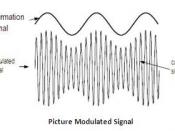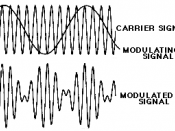TABLE OF CONTENTS:
Introductionâ¦â¦â¦â¦â¦â¦â¦â¦â¦â¦â¦â¦â¦â¦â¦â¦â¦â¦â¦â¦â¦â¦â¦â¦â¦â¦â¦â¦â¦â¦â¦â¦..2
Amplitude Modulationâ¦â¦â¦â¦â¦â¦â¦â¦â¦â¦â¦â¦â¦â¦â¦â¦â¦â¦â¦â¦â¦â¦â¦â¦â¦â¦â¦..3-8
Single side bandsâ¦â¦â¦â¦â¦â¦â¦â¦â¦â¦â¦â¦â¦â¦â¦â¦â¦â¦â¦â¦â¦â¦â¦â¦â¦â¦5
AM transmittersâ¦â¦â¦â¦â¦â¦â¦â¦â¦â¦â¦â¦â¦â¦â¦â¦â¦â¦â¦â¦â¦â¦â¦â¦â¦â¦...7-8
Super heterodyneâ¦â¦â¦â¦â¦â¦â¦â¦...â¦â¦â¦â¦â¦â¦â¦â¦â¦â¦â¦â¦â¦â¦â¦â¦â¦â¦â¦â¦.10
Noiseâ¦â¦â¦â¦â¦â¦â¦â¦â¦â¦â¦â¦â¦â¦â¦â¦â¦â¦â¦â¦â¦â¦â¦â¦â¦â¦â¦â¦â¦â¦â¦.â¦â¦.11-13
Receiver developmentâ¦â¦â¦â¦â¦â¦â¦â¦â¦â¦â¦â¦â¦â¦â¦â¦â¦â¦â¦â¦â¦â¦â¦â¦â¦â¦.14-15
Lab Experimentâ¦â¦â¦â¦â¦â¦â¦â¦â¦â¦â¦â¦â¦â¦â¦â¦â¦â¦â¦â¦â¦â¦â¦â¦â¦â¦â¦â¦â¦.15-17
Conclusionâ¦â¦â¦â¦â¦â¦â¦â¦â¦â¦â¦â¦â¦â¦â¦â¦â¦â¦â¦â¦â¦â¦â¦â¦â¦â¦â¦â¦â¦â¦â¦.â¦.18
Referenceâ¦â¦â¦â¦â¦â¦â¦â¦â¦â¦â¦â¦â¦â¦â¦â¦â¦â¦â¦â¦â¦â¦â¦â¦â¦â¦â¦â¦â¦â¦â¦â¦â¦19
INTRODUCTION
Communication is a two way concept as it needs both transmitter and a receiver. It is one of the most important process that happens within the aviation industry as it makes life easier, and more convenient . With the advancement in communication these days by the use of transmitters and receivers it is necessary to have an understanding about the transmitters and receivers. This covers all the information about the principles of amplitude modulation transmitters, the stages of a super heterodyne system, noise and interference towards radio reception, and development of receivers which are now commonly used today in the aviation industry. Shows information about the lab experiment of modulation and demodulation with the study of amplitude modulation using balance modulator
Amplitude Modulation
Amplitude Modulation are one of the simplest type of modulation compared to frequency modulation and phase modulation.
Its transmitter uses information signal Vm(t) to vary the amplitude of the carrier (VCO) to produce a modulated signal VAM(t).
Information signal:
Before transmitting this signal, it must be first converted into audio into electrical signal with the use of a transducer. After conversion, it is used to modulate a carrier signal.
Carrier signal:
It is used to reduce the wavelength for efficient transmission.
It allows the usage of the same channel simultaneously, called multiplexing.
Signals in mathematical form:
Information: Vm (t)
Carrier: Vc(t) = Vco sin (2ÃÂ fc t+ ÃÂ )
Modulated Signal: VAM(t) = {Vco + VM(t)} sin (2 ÃÂ fc t+ ÃÂ)
Where
V (t) - The voltage of the signal as a function of time
Vo - The amplitude of the signal
f - The frequency of oscillation, number of cycles per second (Hertz...


